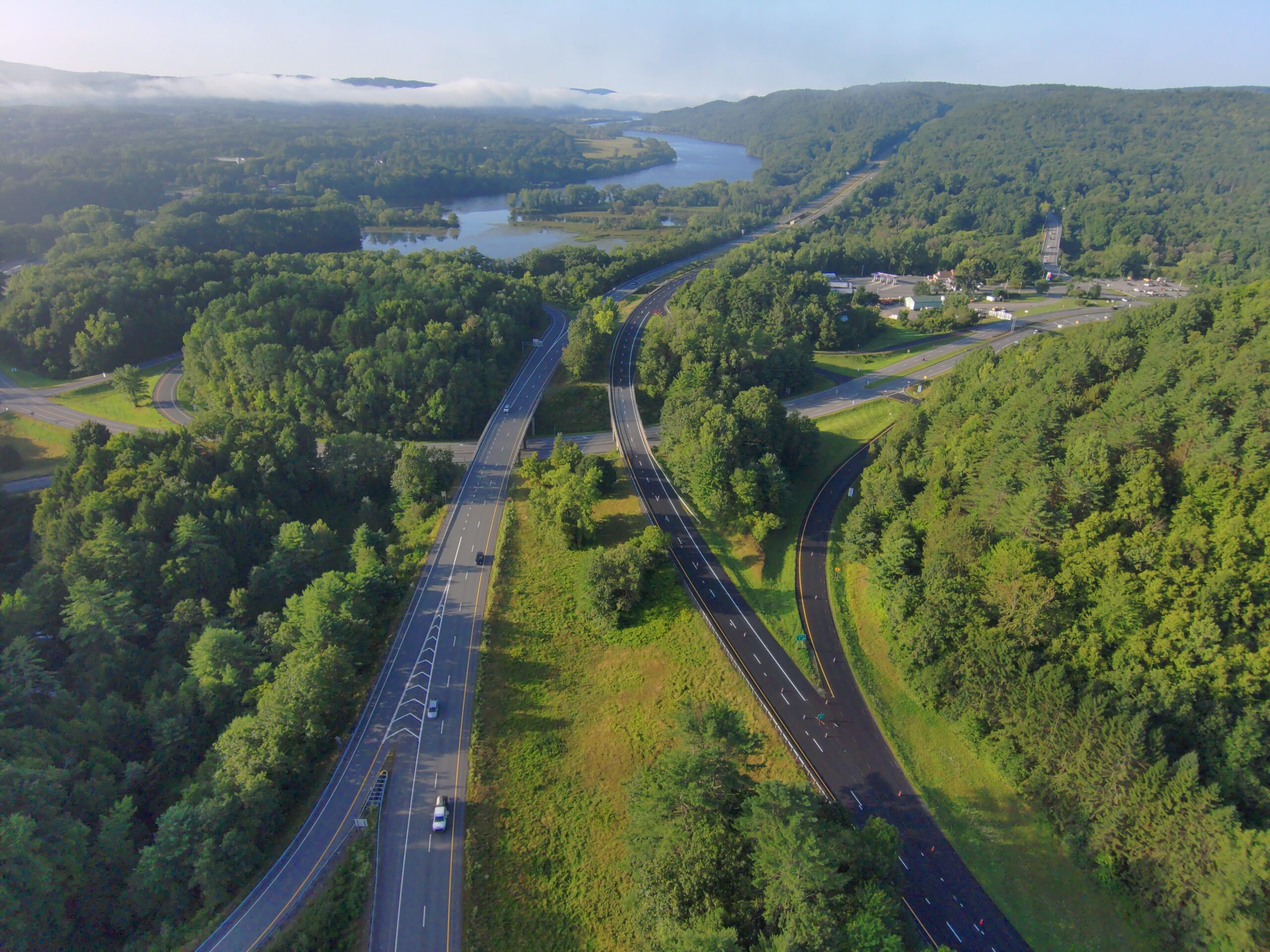
Protecting infrastructure across Vermont
How VTrans is leading with a network-scale approach to resilience
By Jeremy Reed, Andrea Wright and Otis Ellms-Munroe | Vermont Agency of Transportation
At VTrans, our mission is to deliver a safe, reliable and environmentally sustainable transportation system. Many of our roads follow rivers through steep and narrow valleys as well as along pastoral agricultural landscapes. They are vital to the movement of people and goods and essential to enjoy our state’s natural scenery.
To safeguard this network for the long term, we have embraced a strategic, programmatic approach to resilience. Central to this approach is a progression of efforts that together make resilience routine across our organization:
- Predictive tools – Leveraging innovative models to identify where the system is most vulnerable and where improvements will have the greatest impact.
- Planning and programming – Establishing clear goals and priorities that guide long-term investment decisions.
- Design and engineering – Design and constructing infrastructure to standards that can better withstand flooding and erosion while reducing future maintenance needs.
- Funding and investment – Aligning traditional capital dollars with available federal and state programs to accelerate high-value projects and scale resilient practices statewide.
- Emergency response and recovery – Mobilizing quickly when storms hit, restoring connectivity and integrating lessons learned into permanent, more resilient solutions.
This integrated model produces concrete public benefits, including fewer closures, shorter detours, faster recovery, maintained freight access and safer evacuation routes for vulnerable communities.
Predictive tools
Resilience starts with identifying the vulnerabilities of our assets. Predictive tools can show us where vulnerabilities are greatest. One of our most successful predictive tools is the Transportation Resilience Planning Tool (TRPT), among the first of its kind in the nation. The TRPT combines river science, hydraulics and planning to assess vulnerability, criticality and overall risk for assets at the watershed scale. We use TRPT for project identification, scoping, capital programming and hazard-mitigation planning on both state and local networks.
While the TRPT provides a predictive, network-scale view of risk, our Reducing Repeat Damage Tool tracks actual event-based damages, capturing on-the-ground damage history and local knowledge to complement TRPT’s predictive view.
Together, these tools can allow us to rank projects using VTrans’ Project Selection and Prioritization Process (VPSP2), thereby helping to elevate those projects that pose a greater risk. The VPSP2 converts candidate projects into a tiered, fundable capital program using a transparent, data‑driven assessment of need, system performance, cost, deliverability and resiliency. The result is a clear line from analysis to action.
Planning and programming
Resilience begins with clear priorities. At VTrans, those priorities are guided by our Transportation Asset Management Plan which emphasizes risk and resilience and speaks to addressing resilience through project selection processes as well as the Resilience Improvement Plan (RIP), which helps identify vulnerabilities and move the agency from hazard awareness to prioritized action.
Our RIP includes multimodal elements of the transportation system as well as their interconnection with communities, the environment, and economy and defines a concise set of system goals:
- Less damage in the future —Major natural events result in less damage to the transportation system than in the past.
- Systems return to normal quickly —The network reopens rapidly after major events.
- Vermont is resilient for all people —Everyone has safe transportation options to evacuate before or after an event.
- Essential freight movement —Goods continue to be delivered with less disruption and arrive at key distribution points for Vermonters.
- Coordinated resilience efforts - Investments benefit transportation and Vermont’s communities, environment, economy and other critical sectors.
We translate those goals into measurable, data-driven metrics or “flags” that identify high-priority locations for system resilience. Six metrics were used to prioritize locations for resilience projects intended to address river-related hazards. If a location met the conditions for the metric, it was assigned one or more flags. The greater the number of flags, the higher the location's priority for future resilience improvements. High-priority locations are roadway segments with three or more flags and structures with two or more flags. We examine locations with flag counts and seek to align them with capital projects.
Because the RIP is integrated into our Long-Range Transportation Plan, it guides long-term investments rather than a single grant cycle. This ensures resiliency is not a one-off initiative but a sustained strategy.
To bring these priorities to life, we implement resilient designs.
A safe, reliable, and environmentally sustainable multimodal transportation system that grows the economy, is affordable to use and operate, and serves vulnerable populations.
VTrans Vision Statement
Design and engineering resiliency
Vermont’s State Hazard Mitigation Plan consistently ranks flooding and fluvial erosion as the state’s highest hazards. Our design approach reflects that focus.
We have modernized design practices with the Agency of Natural Resources (ANR) to account for channel migration, sediment transport, bank stability and peak flows. We combine structural and nature-based solutions, ensuring that embankments are protected while rivers retain their natural function. Our standard design practice has been to size new structures to span the full width of a channel’s natural banks, which reduces velocities, scour risk, debris blockage and future maintenance needs.
We codified these principles by updating the Hydraulics Manual and statewide hydraulic standards. Updating the Hydraulics Manual raises the baseline level of resilience and aligns FEMA cost‑share with rebuilding to resilient design standards rather than in-kind replacement.
To extend resilience to local networks, we worked with the ANR to produce the Town Highway Road and Bridge Standards for voluntary municipal adoption. Municipalities that adopt these standards and complementary flood-mitigation policies become eligible for an increased state cost share of the non-federal match for FEMA Public Assistance Program grants. The incentive helps scale resilient practice to local roads.
Funding and investing in resiliency
Translating those engineering standards into built improvements requires reliable funding and coordinated investment strategies that prioritize the highest‑risk sites and scale resilient practice across jurisdictions. VTrans employs a blended funding strategy that combines routine capital dollars with available federal grants to expedite work at the highest-risk locations. Traditional funding right-sizes structures and stabilizes slopes; competitive programs, such as PROTECT and FEMA Hazard Mitigation Assistance, help us move more quickly on significant, high-value and innovative interventions.
Collaboration across state agencies strengthens our funding cases. Since Hurricane Irene in 2011, we have closely coordinated with the ANR, Vermont Emergency Management and the Climate Action Office to strategize the most effective use of available funds. The ANR’s watershed planning helps pinpoint where interventions will best reduce risk. At the same time, local hazard-mitigation plans and regional transportation plans incorporate TRPT data, allowing towns and regional planning commissions to demonstrate need with spatial, data-driven evidence.
That alignment is critical when prioritizing funding. Projects delivered in partnership with towns or other agencies share a common thread: a documented, system-wide need backed by shared data and aligned priorities. The result is stronger grant applications, faster approvals and projects that serve both transportation resilience and community resilience.
Emergency response and recovery activities
While long-term planning, design and investment create the foundation for resilience, the true test often comes when extreme weather strikes. In an extreme weather emergency, we activate our Incident Command System and Continuity of Operations Plan. We stabilize, reopen and document, then integrate what we’ve learned into permanent scopes.
After a July 2023 storm, hundreds of miles of roadway and structures were evaluated; we performed emergency repairs and targeted permanent projects. Since then, 825 sites have received emergency repairs and over 60 sites have been identified for permanent projects. Each permanent site has been visited by a resilience strike team and is being designed with resilience in mind, so these locations will be less likely to be damaged again. July 2024 brought another extreme weather event to Vermont. Post event evaluations provided evidence that the infrastructure built to new standards after Tropical Storm Irene is more resilient.
Resilience as routine business
At VTrans, resilience is becoming institutionalized. It influences how we respond, plan, design and fund projects, creating a continuous feedback loop from field observations to statewide policy. It also delivers value by prioritizing investments that avoid repeated repair costs and reduce long‑term maintenance burdens.
By combining proactive planning with resilient design standards and responsive action, VTrans is building a transportation system that not only weathers today’s storms but emerges stronger for the future.
ABOUT THE AUTHORS
 Jeremy Reed
Jeremy Reed
Chief Engineer
Vermont Agency of Transportation
Jeremy is the Chief Engineer for the Vermont Agency of Transportation. Jeremy started working for the Agency in College as a construction inspector before being hired in the Structures Design Section. After a couple years of design work Jeremy went back to the Construction Section and progressed through the ranks to Resident Engineer, Regional Construction Engineer, and Construction Engineer before being named Chief Engineer in 2023. As Chief Engineer, Jeremy is responsible for managing the Highway Division which includes the Asset Management, Project Delivery, Construction and Materials, and the Operations and Safety bureaus.
 Andrea Wright
Andrea Wright
Environmental Policy Manager, Project Delivery Bureau, Environmental
Vermont Agency of Transportation
Andrea has worked for the Vermont Agency of Transportation (VTrans) in an environmental capacity for 25 years. She currently serves in the role of Environmental Policy Manager overseeing the Agency’s efforts related to sustainability - Emissions Reductions and Resilience and Adaptation. She recently Co-Chaired the Vermont Climate Council’s Rural Resilience and Adaptation Subcommittee during the drafting of the 2025 Vermont Climate Action Plan. Andrea has received status as a registered Professional Engineer in Vermont, a Vermont Certified Public Manager, and a Certified Vermont Lean Green Belt.
 Otis Ellms-Munroe
Otis Ellms-Munroe
Environmental Planning Coordinator, Environmental Policy and Sustainability
Vermont Agency of Transportation
Otis is the resilience lead on the Vermont Agency of Transportation’s Environmental Policy and Sustainability team. He manages the ongoing maintenance and development of the Vermont Transportation Resilience Planning Tool (TRPT), leads the Agency’s Resilience Improvement Plan (RIP) development and implementation, and coordinates on transportation resilience policy and planning with internal and external Agency partners.
